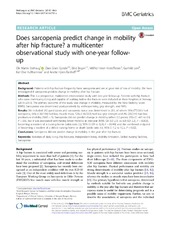| dc.contributor.author | Steihaug, Ole Martin | en_US |
| dc.contributor.author | Ranhoff, Anette Hylen | en_US |
| dc.contributor.author | Gjesdal, Clara Gram | en_US |
| dc.contributor.author | Bogen, Bård Erik | en_US |
| dc.contributor.author | Lien, Gunhild | en_US |
| dc.contributor.author | Kristoffersen, Målfrid Holen | en_US |
| dc.contributor.author | Hufthammer, Karl Ove | en_US |
| dc.date.accessioned | 2018-08-07T12:36:41Z | |
| dc.date.available | 2018-08-07T12:36:41Z | |
| dc.date.issued | 2018-03-05 | |
| dc.Published | Steihaug OM, Ranhoff AH, Gjesdal C, Bogen BE, Lien G, Kristoffersen MH, Hufthammer KO. Does sarcopenia predict change in mobility after hip fracture? A multicenter observational study with one-year follow-up. BMC Geriatrics. 2018;18:65 | eng |
| dc.identifier.issn | 1471-2318 | |
| dc.identifier.uri | https://hdl.handle.net/1956/18021 | |
| dc.description.abstract | Background: Patients with hip fracture frequently have sarcopenia and are at great risk of loss of mobility. We have investigated if sarcopenia predicts change in mobility after hip fracture. Methods: This is a prospective, multicenter observational study with one-year follow-up. Patients with hip fracture who were community-living and capable of walking before the fracture were included at three hospitals in Norway (2011–2013). The primary outcome of the study was change in mobility, measured by the New Mobility Score (NMS). Sarcopenia was determined postoperatively by anthropometry, grip strength, and NMS. Results: We included 282 participants and sarcopenia status was determined in 201, of whom 38% (77/201) had sarcopenia, 66% (128/194) had low muscle mass, 52% (116/222) had low grip strength and 8% (20/244) had low pre-fracture mobility (NMS < 5). Sarcopenia did not predict change in mobility (effect 0.2 points; 95% CI –0.5 to 0.9, P = 0.6), but it was associated with having lower mobility at one-year (NMS 5.8 (SD 2.3) vs. 6.8 (SD 2.2), P = 0.003), becoming a resident of a nursing home (odds ratio 3.2, 95% CI 0.9 to 12.4, P = 0.048), and the combined endpoint of becoming a resident of a skilled nursing home or death (odds ratio 3.6, 95% CI 1.2 to 12.2, P = 0.02). Conclusions: Sarcopenia did not predict change in mobility in the year after hip fracture | en_US |
| dc.language.iso | eng | eng |
| dc.publisher | BioMed Central | eng |
| dc.relation.ispartof | <a href="http://hdl.handle.net/1956/18384" target="blank"> Sarcopenia in patients with hip fracture. A multicenter prospective study with one-year follow-up</a> | |
| dc.rights | Attribution CC BY | eng |
| dc.rights.uri | http://creativecommons.org/licenses/by/4.0 | eng |
| dc.subject | Activities of daily living | eng |
| dc.subject | Hip fractures | eng |
| dc.subject | Independent living | eng |
| dc.subject | Mobility limitation | eng |
| dc.subject | Skilled nursing facilities | eng |
| dc.subject | Sarcopenia | eng |
| dc.title | Does sarcopenia predict change in mobility after hip fracture? A multicenter observational study with one-year follow-up | en_US |
| dc.type | Peer reviewed | |
| dc.type | Journal article | |
| dc.date.updated | 2018-03-06T21:02:10Z | |
| dc.description.version | publishedVersion | en_US |
| dc.rights.holder | Copyright 2018 The Author(s) | |
| dc.identifier.doi | https://doi.org/10.1186/s12877-018-0755-x | |
| dc.identifier.cristin | 1570968 | |
| dc.source.journal | BMC Geriatrics | |

